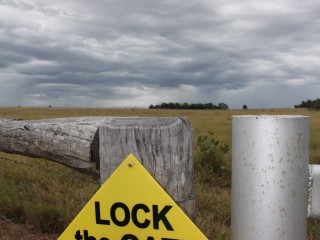 On the rich black soils of the inner Darling Downs, a fight is brewing that could have ramifications for groundwater users all over Australia.
On the rich black soils of the inner Darling Downs, a fight is brewing that could have ramifications for groundwater users all over Australia.
A group of 13 farming families has launched a legal challenge in Queensland’s Land Court against a Queensland Government department’s decision to grant an environmental authority to Arrow Energy Pty Ltd to drill for coal seam gas beneath their irrigated farming land.
The court action, initiated by farmers from the “Save Our Darling Downs” action group, has secured the support and financial backing of the National Farmers Federation’s Australian Farmers Fighting Fund.
The farmers are challenging what they see as inadequate conditioning by the Queensland Department of Enviroment and Resource Management to prevent water, land and lifestyle impacts in the environmental authority it has approved for Arrow Energy’s CSG project.
The action is being viewed as a test case that could define the rights of coal seam gas companies to operate in areas of prime agricultural land and in close proximity to significant freshwater aquifers of the Great Artesian Basin.
At particular issue is the Queensland Government’s repeated assurances that any damage caused to farming land or freshwater aquifers as a result of Coal Seam Gas extraction will be “made good”.
Farmers believe the Government’s conditions when dealing with natural assets of significant environmental value should be focused on preventing damage before it occurs. They also question the capacity of CSG companies or the Government to physically “make good” damage that occurs to aquifers or flood plain soils after the event.
Coal Seam Gas production involves sinking wells into coal seams where natural gas, primarily methane, is trapped by high pressure water. The extraction process involves “dewatering” seams by pumping water to the surface to release the pressure and allow gases to flow. A separator at the well head directs the produced water, which can be high in salt content, into pipes to holding or treatment facilities, while the extracted gas is piped to storage and compressor stations.
Landholders have long expressed concerns about the potential for deep CSG wells that pass through multiple freshwater and geological formations to drain or contaminate interconnected freshwater aquifers that are relied upon for drinking water, stock water and irrigation. They are also concerned about the potential for toxic produced water to contaminate and damage farming lands, and impacts of CSG activities on their businesses and lifestyles.
The Queensland Government has maintained that the creation and monitoring of trigger thresholds means that impacts to groundwater are likely to be prevented before they reach significant levels. It also argues that any damage caused will be fixed under its “make good” provisions.
Farmers say they are yet to see evidence that damage can be made good, and believe that should happen before activities that could cause damage are allowed to occur.
The Land Court action will deal specifically with Arrow Energy’s project to extract water and gas from the Walloon Coal Measures, a coal seam of the Great Artesian Basin that lies directly below the Condamine Alluvium, Queensland’s largest freshwater aquifer.
A 2010 analysis of geological formations in the region by former chief Queensland Government hydrologist John Hillier confirmed that the Walloon Coal Measures and the Condamine Alluvium were directly interconnected, and high-volume extraction of water from the Walloons during CSG production could cause significant losses of freshwater from the Condamine Alluvium.
If the landholders’ action is successful, it is believed it could result in greater conditions being imposed on CSG activities to provide greater protection for environmental assets, which in turn would set a legal precedent that could shape CSG activities in other areas.
“To date the CSG industry has been able to operate with all of the conditions it needs to operate, but those conditions are not necessarily conducive to what we as farmers need to operate,” Darling Downs farmer Graham Clapham said.
“If there is going to be some co-existence between agriculture and industry, the environmental assets that are important to agriculture must also be protected.”
